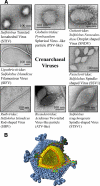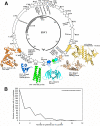Structural and functional studies of archaeal viruses
- PMID: 19158076
- PMCID: PMC2675988
- DOI: 10.1074/jbc.R800078200
Structural and functional studies of archaeal viruses
Abstract
Viruses populate virtually every ecosystem on the planet, including the extreme acidic, thermal, and saline environments where archaeal organisms can dominate. For example, recent studies have identified crenarchaeal viruses in the hot springs of Yellowstone National Park and other high temperature environments worldwide. These viruses are often morphologically and genetically unique, with genomes that show little similarity to genes of known function, complicating efforts to understand their viral life cycles. Here, we review progress in understanding these fascinating viruses at the molecular level and the evolutionary insights coming from these studies.
Figures


References
-
- Suttle, C. A. (2007) Nat. Rev. Microbiol. 5 801–812 - PubMed
-
- Sorek, R., Kunin, V., and Hugenholtz, P. (2008) Nat. Rev. Microbiol. 6 181–186 - PubMed
-
- Bell, P. J. (2001) J. Mol. Evol. 53 251–256 - PubMed
-
- Zillig, W., Prangishvilli, D., Schleper, C., Elferink, M., Holz, I., Albers, S., Janekovic, D., and Gotz, D. (1996) FEMS Microbiol. Rev. 18 225–236 - PubMed
Publication types
MeSH terms
LinkOut - more resources
Full Text Sources

